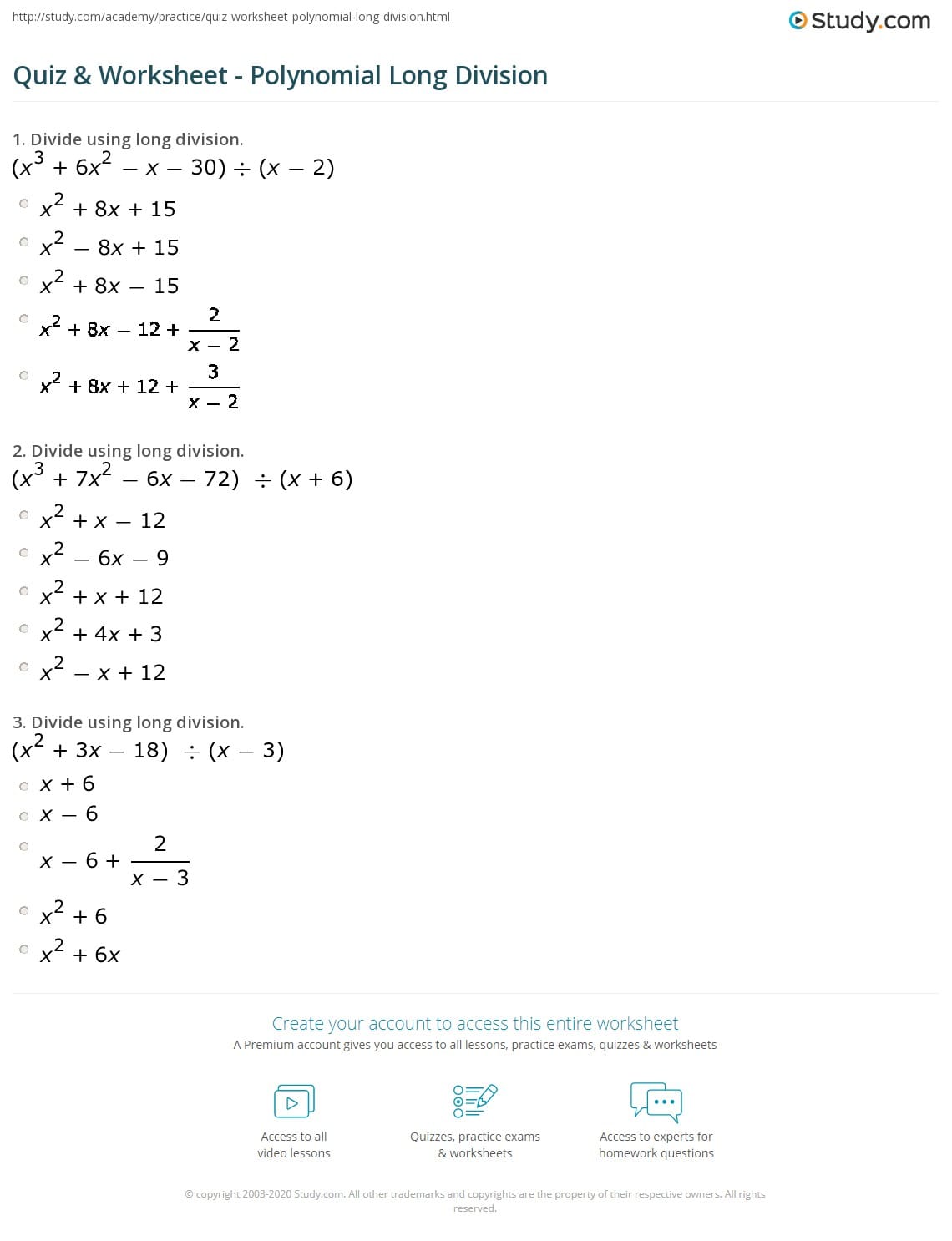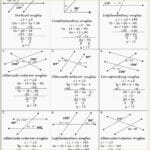Dive into the world of polynomial division with this comprehensive guide. Whether you’re a beginner or looking to brush up on your skills, this resource provides clear explanations, practical examples, free worksheets, and answer keys to help you conquer polynomial division.
Understanding Polynomial Division
Working with polynomials can feel challenging, but dividing them is a logical process you can absolutely master. It’s a fundamental skill in algebra, essential for simplifying expressions, understanding function behavior, and much more. This guide breaks down polynomial division into digestible steps, exploring various methods and providing ample practice resources. If you need help with chemistry, utilize our extensive collection of chemistry resources. We have practice questions, periodic tables, a list of elements, and a comprehensive counting atoms worksheet that can help you understand the fundamentals of counting atoms.
Different Approaches to Polynomial Division
Several methods exist for dividing polynomials. Let’s explore the most common and effective:
1. Long Division: The Reliable Method
This method mirrors long division with numbers, incorporating variables and exponents. It’s a versatile technique suitable for any polynomial division problem.
- Step 1: Arrange and Align: Arrange both the dividend (what’s being divided) and the divisor in descending order of exponents. Insert placeholder terms with zero coefficients for any missing exponent terms (e.g., 0x² if you have x³ and x but no x²) to maintain alignment.
- Step 2: Divide: Divide the leading term of the dividend by the leading term of the divisor to obtain the first term of the quotient.
- Step 3: Multiply and Subtract: Multiply the entire divisor by the first term of the quotient and subtract the result from the dividend.
- Step 4: Bring Down and Repeat: Bring down the next term from the dividend and repeat steps 2 and 3. Continue until the remainder is zero or has a lower degree than the divisor.
2. Synthetic Division: The Efficient Shortcut
Synthetic division simplifies the process, but it’s specifically for divisors in the form (x – c) or (x + c), where ‘c’ is a constant.
- Step 1: Set Up: Write the dividend’s coefficients in a row, including zeros for missing terms. Place ‘c’ to the left.
- Step 2: Bring Down: Bring down the first coefficient.
- Step 3: Multiply and Add: Multiply ‘c’ by the number brought down, write the product below the next coefficient, and add the two numbers.
- Step 4: Repeat and Interpret: Repeat the multiply-and-add process. The bottom row contains the quotient’s coefficients (one degree less than the dividend), and the last number is the remainder.
3. Factorization: When Divisors are Factors
This method is useful when the divisor is a factor of the dividend.
- Step 1: Factor: Completely factor both the dividend and the divisor.
- Step 2: Cancel: Cancel out any common factors.
- Step 3: Simplify: Multiply remaining numerator factors to get the quotient.
4. Box Method: A Visual Aid (for Simpler Problems)
The box method provides a visual representation for simpler divisions, based on the concept of area. However, for more complex problems, other methods are typically easier to manage.
Practice and Tips
Mastering polynomial division requires practice. Start with easier problems, gradually increasing complexity. Break down problems into smaller steps, and always verify your answers. Don’t hesitate to seek help from teachers or online resources when needed. Many online tutoring platforms specialize in polynomial division.
Delving Deeper into Polynomial Division
Polynomial division, like standard long division, involves dividing one polynomial by another. It’s a crucial tool in algebra for simplifying expressions, finding roots, and solving higher-order equations. This section explores the why behind polynomial division, its significance, and its connections to other mathematical concepts.
Why is Polynomial Division Important?
Polynomial division has broad applications across various fields:
- Engineering: Optimizing volume and area, analyzing stress and strain in structures, and critical design calculations.
- Physics: Analyzing projectile motion, understanding oscillations and waves, and circuit analysis.
- Computer Science: Algorithm development, data modeling, and cryptography.
It also helps us understand polynomial behavior, which is useful for graphing and analysis. Furthermore, it simplifies complex mathematical expressions, making calculations more manageable.
Connecting to Key Concepts
Polynomial division is intrinsically linked to:
- The Remainder Theorem: When a polynomial f(x) is divided by (x – c), the remainder is f(c).
- The Factor Theorem: (x – c) is a factor of f(x) if and only if f(c) = 0 (i.e., the remainder is zero).
- Rational Functions: Polynomial division is essential for simplifying and analyzing rational functions (fractions with polynomials).
Exploring Further
Current research in computational algebra is constantly refining algorithms for polynomial division, particularly for high-degree polynomials. This active field may likely lead to more efficient methods in the future.
Mastering Long Division
Let’s delve into the specifics of polynomial long division with a detailed, step-by-step guide.
Step-by-Step Guide
- Setup: Arrange both the dividend and the divisor in descending powers of x. Use zero coefficients as placeholders for any missing terms.
- Divide: Divide the leading term of the dividend by the leading term of the divisor to get the first term of the quotient.
- Multiply: Multiply the entire divisor by the first term of the quotient.
- Subtract: Subtract the result from the dividend.
- Bring Down: Bring down the next term of the dividend.
- Repeat: Repeat steps 2-5 until the degree of the remainder is less than the degree of the divisor.
Example
Divide x³ + 2x – 1 by x – 1:
x² + x + 3
---------
x - 1 | x³ + 0x² + 2x - 1
- (x³ - x²)
---------
x² + 2x
- (x² - x)
---------
3x - 1
- (3x - 3)
---------
2
Quotient: x² + x + 3, Remainder: 2
Applications
Long division is crucial for:
- Simplifying algebraic fractions.
- Finding polynomial roots.
- Analyzing rational functions.
Synthetic Division: A Streamlined Approach
Synthetic division provides a faster alternative for specific cases, typically when the divisor is linear.
Step-by-Step Guide
- Set up: Write the coefficients of the dividend (including zeros for missing terms) and the ‘k’ value from the divisor (x – k).
- Bring down: Bring down the first coefficient.
- Multiply and add: Multiply ‘k’ by the number below the line and add it to the next coefficient. Repeat.
- Interpret: The last number is the remainder, and the others are coefficients of the quotient (one degree less than the dividend).
Example
Divide x³ – 5x² + 3x + 2 by (x – 2):
2 | 1 -5 3 2
---------
1 -3 -3 -4
Quotient: x² – 3x – 3, Remainder: -4
Applications
Synthetic division is particularly useful for:
- Finding roots (remainder = 0 implies a root).
- Factorization.
- Polynomial evaluation.
The Factor and Remainder Theorems
These theorems are fundamental to understanding polynomial behavior.
The Remainder Theorem
When a polynomial f(x) is divided by (x – c), the remainder is f(c).
The Factor Theorem
(x – c) is a factor of f(x) if and only if f(c) = 0.
Working Together
These theorems are useful for finding roots and factors of polynomials, simplifying division, and providing insights into polynomial behavior. While the information they offer is similar, they provide different perspectives on the relationship between roots, factors, and remainders. Current research continues to explore the theoretical implications of these theorems in abstract algebra. For additional practice, explore the numerous free worksheets and practice problems available online.
- Unlock Water’s Symbolism: A Cross-Cultural Exploration - April 20, 2025
- Identify Black and White Snakes: Venomous or Harmless? - April 20, 2025
- Unlocking Potential: Origins High School’s NYC Story - April 20, 2025
















1 thought on “Dividing Polynomials Worksheets: A Comprehensive Guide with Free Printables and Answer Keys”
Comments are closed.